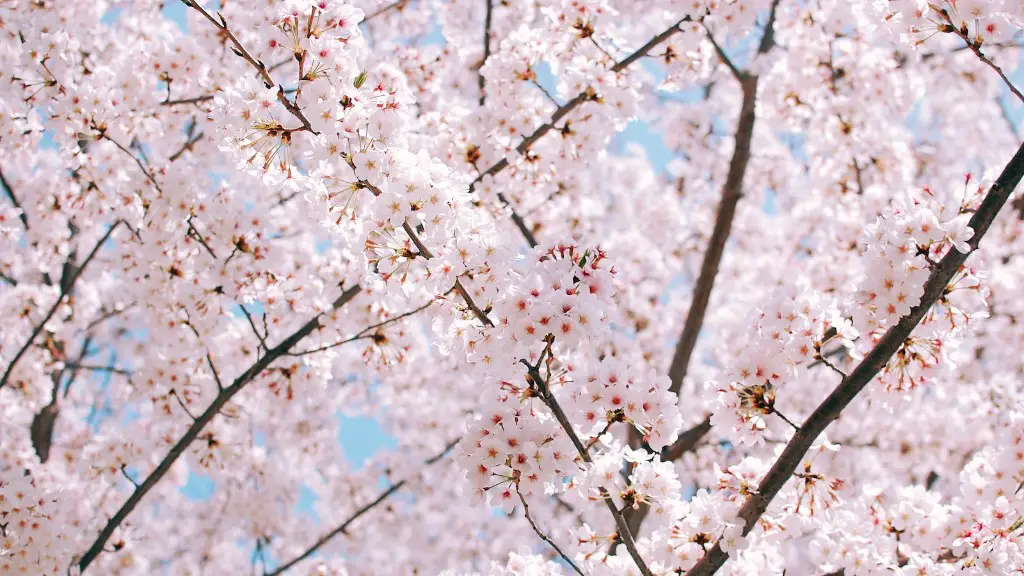Taming an overgrown cherry tree is a daunting task, but it can be completed with some time and patience. The most important thing to remember is to prune properly and carefully. Poor pruning can cause irreparable damage to the tree and make it more susceptible to disease and pests. Fortunately, there are a few key steps to keep in mind when pruning a cherry tree.
The first step in pruning an overgrown cherry tree is to assess the size and shape of the tree. Take note of how many branches are growing too close together, or how many plants or weeds are growing near the base of the tree. Make sure that the branches are evenly spaced and not crowding each other. If the tree is in need of reshaping, begin by removing the dead, weak, or damaged branches. These can be removed completely, right down to the trunk.
Once the dead and weak branches have been removed, it is time to begin pruning the live branches. For thinning out the tree, look for branches that cross or rub against each other, as well as branches that have grown too large (known as ‘suckers’). These can be pruned carefully with a sharp pair of pruning shears. The cut should be made close to the base but without cutting into the bark. If the tree is in need of shaping, start by pruning the longest branches, aiming to keep the general structure of the tree. Remember to angle the cuts away from the centre of the tree for best results.
As well as thinning and shaping, it is also important to encourage new growth on the cherry tree. This can be done by trimming the branches in areas that need extra light, such as those at the sides or the very top of the tree. If there are any dead or weak shoots, these should be removed to make way for new shoots to form. To achieve a well-balanced structure, the remaining branches should be pruned so that they extend evenly in all directions.
It is also essential to pay attention to the height of the tree when pruning. If the cherry tree has grown too tall and is obstructing the view, it is necessary to prune away the branches at the top of the tree to limit its height. Pruning away the top of the tree will also help to reduce the amount of shade it casts on the area. Be sure not to prune too much off the top, as this could leave the tree looking bare.
For safety reasons, it is best to prune the cherry tree on a dry day, with no strong winds. This will make it easier to see what areas need pruning, and will also prevent the tree from being damaged by the wind. To protect yourself while pruning, it is important to wear gloves, a long-sleeved shirt and shoes with good grip.
Overall, it is important to take time and make sure that each cut is made correctly when pruning an overgrown cherry tree. With careful pruning, the tree will stay healthy and retain its natural shape. Using the above steps, it is possible to keep your cherry tree in check and looking great.
Pruning But Don’t Over Prune
When pruning an overgrown cherry tree, it is important not to overdo it. Pruning too much can stress the tree and prevent it from growing properly. Therefore, you should prune only what is necessary in order to shape the tree and encourage new growth. It is important to remember to never prune more than a third of the tree at any one time. This way, you will give the tree plenty of time to recover and grow.
When to Prune a Cherry Tree
For maximum benefits, the best time to prune a cherry tree is during the late winter or early spring, before the buds have opened. Pruning during this time will help the tree to grow stronger and more resilient, ready for the summer. It is important to prune away any dead or damaged branches before the growing season begins and to make sure that the remaining branches are evenly spread. This will help to promote growth and prevent the tree from becoming overgrown again.
Keep an Eye Out for Pests and Diseases
Another factor to consider when pruning an overgrown cherry tree is pest and diseases. Cherry trees are susceptible to a range of pests, such as aphids, scale and mite infestations, and to diseases, such as black knot and sooty mold. It is therefore important to check for signs of these problems when pruning, and to take action if needed. For example, pruning away dead or damaged branches can help to reduce the risk of an infestation or infection.
Fertilization and Watering
Once you have completed pruning your cherry tree, it is important to take steps to keep it healthy and vigorous. This includes fertilizing the tree in the spring and summer, and making sure that it is watered regularly during dry periods. If the tree is struggling to recover, you may need to provide additional fertilizer or water. In severe cases, it may be necessary to replace the tree with a healthier one.
In Summary
Pruning an overgrown cherry tree can be a daunting task, however with some time and patience it can be done. The most important thing to remember is to assess the size and shape of the tree first and then to prune away any dead or weak branches. Aim to prune only a third of the tree at any one time and do not over prune as this can lead to weak, unsteady growth. It is also important to keep an eye out for pests, diseases and to fertilize and water the tree regularly.

